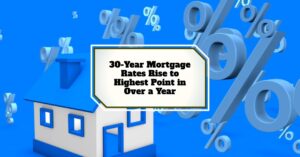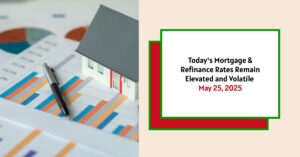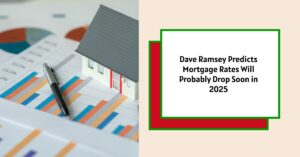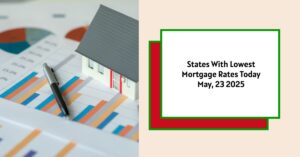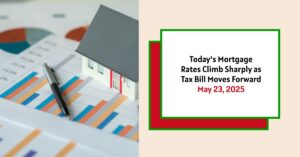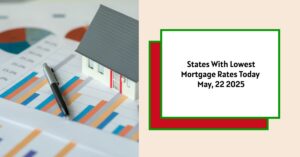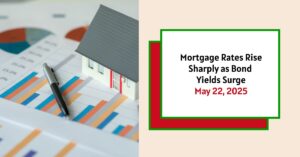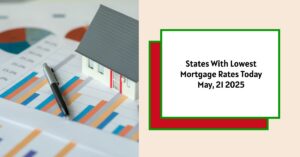The average interest rate on a 30-year fixed-rate mortgage has climbed to 7.15%, marking the highest point we've seen in over a year, specifically since May 2, 2024. This increase has ripple effects across the housing market and impacts affordability for many. Let's delve deeper into what this means, the factors driving this change, and what potential homebuyers and homeowners should consider.
30-Year Mortgage Rates Rise to Highest Point in Over a Year
Breaking Down the Current Mortgage Rate Environment
It's crucial to understand the specifics of these rising rates. The 7.15% average for a 30-year fixed-rate mortgage for new purchases represents a 4 basis point increase just from yesterday. While seemingly small, these incremental increases can significantly impact your monthly payments and the total cost of your homeownership journey.
Here's a snapshot of the national averages for various mortgage types, as per Zillow:
| Loan Type | New Purchase Rate | Daily Change |
|---|---|---|
| 30-Year Fixed | 7.15% | +0.04 |
| FHA 30-Year Fixed | 7.37% | No Change |
| 15-Year Fixed | 6.13% | +0.02 |
| Jumbo 30-Year Fixed | 7.16% | +0.06 |
| 5/6 ARM | 7.54% | +0.01 |
As you can see, the increase isn't isolated to the 30-year fixed-rate. Other common mortgage types, like the 15-year fixed and jumbo loans, have also seen upward movement. It's worth noting that rates for different loan types respond to various market forces, though they often trend in the same general direction.
Perspective is Key: Contextualizing Today's Rates
To truly grasp the significance of the current 30-year mortgage rates, it's helpful to look back. While 7.15% is the highest in over a year, it's important to remember the volatility we've experienced in the recent past. Back in September of last year, we saw a considerable dip, with 30-year rates reaching a two-year low of 5.89%. That was a period of greater affordability.
Conversely, if we look further back to late 2023, rates had surged to a historic 23-year peak of 8.01%. Compared to that high point, today's rates are still somewhat lower. This highlights the dynamic nature of the mortgage market and how quickly things can change.
The 15-year fixed-rate mortgage tells a similar story. While currently at 6.13%, it's below the near one-year high of 6.31% from April and significantly lower than the 23-year peak of 7.08% in October 2023. Just like the 30-year, the 15-year rate also experienced a two-year low last September at 4.97%.
Even jumbo 30-year rates, which now average 7.16% (a 10-month high), are below their estimated 20-plus year peak of 8.14% from October 2023. Last fall's low of 6.24% for jumbo loans illustrates the recent fluctuations.
These comparisons underscore that while today's rates are elevated compared to the recent past, they aren't unprecedented. However, for those looking to buy now, the increased cost of borrowing is a real factor to consider.
What's Driving These Higher Mortgage Rates?
Understanding why mortgage rates rise and fall is crucial. It's not as simple as just one factor; rather, it's a complex interplay of several economic forces:
- The Bond Market, Particularly 10-Year Treasury Yields: Mortgage rates tend to closely follow the yield on 10-year Treasury bonds. These bonds are seen as a safe investment, and their yields reflect investor confidence and expectations about the economy. When Treasury yields rise, mortgage rates typically follow suit.
- Federal Reserve Monetary Policy: The Federal Reserve's actions, particularly concerning bond buying and its target for the federal funds rate, can indirectly influence mortgage rates. While the fed funds rate doesn't directly set mortgage rates, the Fed's overall monetary stance impacts the broader economy and investor sentiment, which in turn affects bond yields and mortgage rates. For instance, the Fed's aggressive rate hikes in 2022 and 2023 to combat inflation had a significant upward impact on mortgage rates.
- Inflation Expectations: If investors and lenders expect inflation to remain high, they will demand higher returns on long-term investments like mortgages, leading to increased rates.
- Economic Growth and Stability: A strong and stable economy can sometimes lead to higher interest rates as demand for credit increases. Conversely, economic uncertainty can sometimes push rates down as investors seek safer assets.
- Competition Among Lenders: While macroeconomic factors are primary drivers, the level of competition within the mortgage industry can also play a role in the rates offered to borrowers.
In my opinion, the recent uptick in 30-year mortgage rates is likely a reflection of continued economic resilience, persistent (though moderating) inflation, and perhaps a recalibration of expectations regarding how quickly and significantly the Federal Reserve will cut interest rates this year. The fact that the Fed decided to hold rates steady at their last meeting, and projections suggest potentially fewer rate cuts than initially anticipated, likely contributes to this upward pressure on longer-term borrowing costs.
The Impact of Higher Mortgage Rates on You
For anyone looking to enter the housing market or refinance, these higher 30-year mortgage rates have tangible consequences:
- Reduced Affordability: Higher interest rates directly translate to higher monthly mortgage payments for the same loan amount. This can shrink the pool of buyers who can comfortably afford a home at current prices, potentially leading to decreased demand.
- Lower Borrowing Power: With higher rates, the maximum loan amount you can qualify for might decrease. This could limit the price range of homes you can consider.
- Impact on Refinancing: Homeowners who were hoping to refinance their existing mortgages to secure a lower monthly payment may find that current rates don't offer a significant advantage, or even result in a higher payment.
- Potential Cooling of the Housing Market: If higher rates persist, we could see a further cooling of the housing market as demand moderates. This could potentially lead to slower price appreciation or even price reductions in some areas.
Strategies for Navigating the Current Rate Environment
Despite the increase in 30-year mortgage rates, there are still steps potential homebuyers and homeowners can take:
- Shop Around Diligently: As the data consistently shows, rates vary significantly between lenders. It's more crucial than ever to get quotes from multiple lenders and compare not just the interest rate but also fees and closing costs.
- Consider Different Loan Types: While the 30-year fixed-rate is the most popular, exploring other options like 15-year fixed-rate mortgages (which often have lower interest rates but higher monthly payments) or adjustable-rate mortgages (ARMs) might be worth considering, depending on your financial situation and risk tolerance. However, with rates currently being somewhat elevated, locking in a fixed rate might offer more long-term stability.
- Strengthen Your Financial Profile: Improving your credit score and reducing your debt-to-income ratio can help you qualify for better interest rates.
- Be Prepared to Negotiate: In a potentially cooling market, there might be more room to negotiate on the price of a home.
- Consider a Larger Down Payment: A larger down payment reduces the loan amount, which can lower your monthly payments and potentially your interest rate.
- Don't Try to Time the Market: Predicting interest rate movements is incredibly difficult. Focus on finding a home you can afford comfortably within your long-term financial goals.
Freddie Mac's Weekly Averages vs. Daily Readings
It's worth noting the difference between the daily rates we've discussed and the weekly averages published by Freddie Mac. As of yesterday, Freddie Mac's weekly average for 30-year mortgages was 6.86%. This difference arises because Freddie Mac calculates a weekly average that blends the rates from the previous five days, whereas the figures we've been looking at are daily snapshots, offering a more immediate view of rate changes. Additionally, the criteria for the loans included in each calculation (like down payment size and credit score assumptions) can vary.
The Bottom Line
The recent increase in 30-year mortgage rates to the highest level in over a year is a significant development for the housing market. While still below the peak we saw in late 2023, these higher rates impact affordability and borrowing power. Understanding the factors driving these changes and exploring different strategies will be crucial for anyone looking to navigate the current real estate landscape. Remember to shop around, consider your financial situation carefully, and focus on making informed decisions that align with your long-term goals.
Invest Smarter in a High-Rate Environment
With mortgage rates remaining elevated this year, it's more important than ever to focus on cash-flowing investment properties in strong rental markets.
Norada helps investors like you identify turnkey real estate deals that deliver predictable returns—even when borrowing costs are high.
HOT NEW LISTINGS JUST ADDED!
Connect with a Norada investment counselor today (No Obligation):
(800) 611-3060
Also Read:
- Will Mortgage Rates Go Down in 2025: Morgan Stanley's Forecast
- Expect High Mortgage Rates Until 2026: Fannie Mae's 2-Year Forecast
- Mortgage Rate Predictions 2025 from 4 Leading Housing Experts
- Mortgage Rates Forecast for the Next 3 Years: 2025 to 2027
- 30-Year Mortgage Rate Forecast for the Next 5 Years
- 15-Year Mortgage Rate Forecast for the Next 5 Years
- Why Are Mortgage Rates Going Up in 2025: Will Rates Drop?
- Why Are Mortgage Rates So High and Predictions for 2025
- Will Mortgage Rates Ever Be 3% Again in the Future?
- Mortgage Rates Predictions for Next 2 Years
- Mortgage Rate Predictions for Next 5 Years
- Mortgage Rate Predictions: Why 2% and 3% Rates are Out of Reach
- How Lower Mortgage Rates Can Save You Thousands?
- How to Get a Low Mortgage Interest Rate?
- Will Mortgage Rates Ever Be 4% Again?
